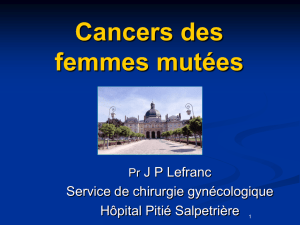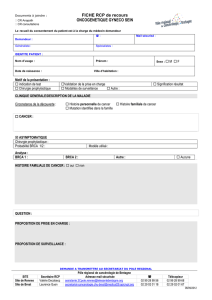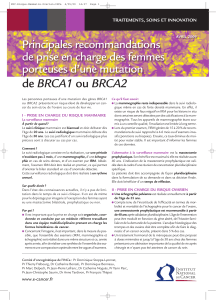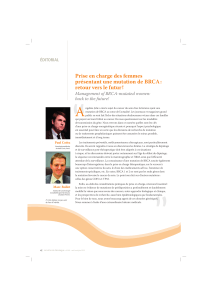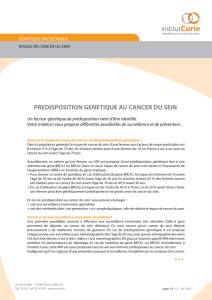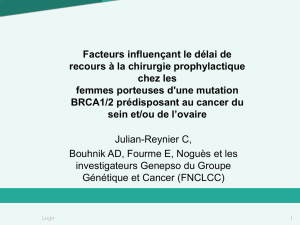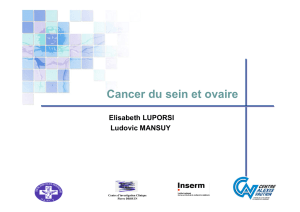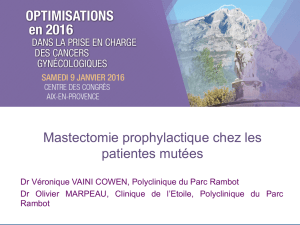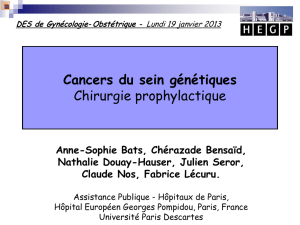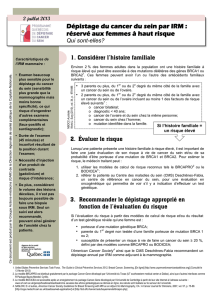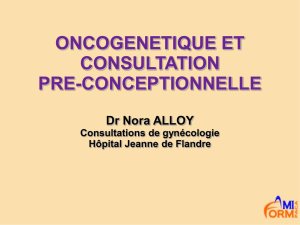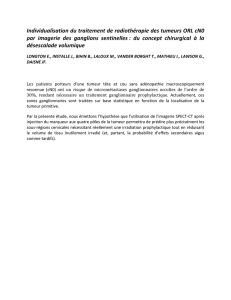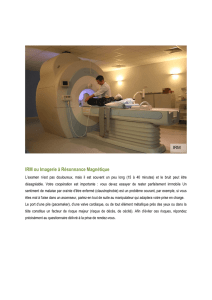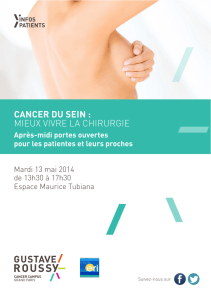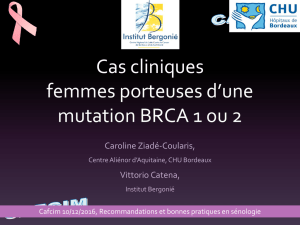CHIRURGIE PROPHYLACTIQUE
publicité
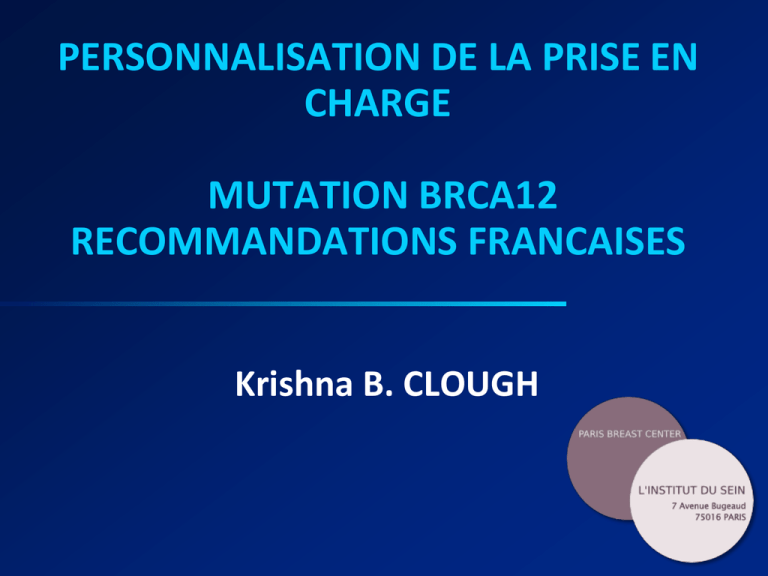
PERSONNALISATION DE LA PRISE EN CHARGE MUTATION BRCA12 RECOMMANDATIONS FRANCAISES Krishna B. CLOUGH CHIRURGIE PROPHYLACTIQUE : InCA 2009 2 FEMMES MUTEES BRCA 1 MUTATION CONFIRMEE BRCA12 Mutation BRCA 1 Risque K sein (70 ans): 40-85 % Risque K ovaire : 20-45 % MUTATION CONFIRMEE BRCA12 Mutation BRCA 1 Risque K sein (70 ans): 40-85 % Risque K ovaire : 20-45 % Mutation BRCA2 K sein : 40-85 % K ovaire : 10-25 % MUTATION CONFIRMEE BRCA12 Mutation BRCA 1 Risque K sein (70 ans): 40-85 % Risque K ovaire : 20-45 % Mutation BRCA2 K sein : 40-85 % K ovaire : 10-25 % Risque cumulé K sein ou ovaire 90 % MUTATION BRCA 12 RISQUE ANNUEL CANCER DU SEIN Antoniou AmJHumGen2003 MUTATION BRCA 12 RISQUE ANNUEL CANCER DU SEIN: 2-3% Antoniou AmJHumGen2003 MUTATION BRCA12 STRATÉGIES DE PRISE EN CHARGE 1. Hormonothérapie 2. Surveillance et dépistage précoce 3. Chirurgie 1. Mastectomie prophylactique 2. Ovariectomie prophylactique MUTATION BRCA12 STRATÉGIES DE PRISE EN CHARGE 1. Hormonothérapie 2. Surveillance et dépistage précoce 3. Chirurgie 1. Mastectomie prophylactique 2. Ovariectomie prophylactique HORMONOTHERAPIE PROPHYLACTIQUE BRCA12 : RECOMMANDATIONS 2009 MUTATION BRCA12 HORMONOTHERAPIE PREVENTIVE ? 2464 BRCA12 K sein unilat Phillips JCO 2013 TAM réduit 60% risque KS controlat MUTATION BRCA12 HORMONOTHERAPIE PREVENTIVE ? 2464 BRCA12 K sein unilat Phillips JCO 2013 TAM réduit 60% risque KS controlat MAP3 4560 FAR post MNP Goss NEJM 2011 IA (Exemestane) reduit 65% risque KS MUTATION BRCA12 HORMONOTHERAPIE PREVENTIVE ? 2464 BRCA12 K sein unilat Phillips JCO 2013 TAM réduit 60% risque KS controlat MAP3 4560 FAR post MNP Goss NEJM 2011 IA (Exemestane) reduit 65% risque KS IBIS II 3864 FAR post MNP Cuzik Lancet 2014 IA (Anastrozole) réduit 50% risque KS MUTATION BRCA12 HORMONOTHERAPIE PREVENTIVE ? 2464 BRCA12 K sein unilat Phillips JCO 2013 TAM réduit 60% risque KS controlat MAP3 4560 FAR post MNP Goss NEJM 2011 IA (Exemestane) reduit 65% risque KS IBIS II 3864 FAR post MNP Cuzik Lancet 2014 IA (Anastrozole) réduit 50% risque KS 2015: Recommandation hormonothérapie? MUTATION BRCA12 STRATÉGIES DE PRISE EN CHARGE 1. Hormonothérapie 2. Surveillance et dépistage précoce 3. Chirurgie 1. Mastectomie prophylactique 2. Ovariectomie prophylactique SURVEILLANCE MAMMAIRE BRCA12 DEPISTAGE DES FEMMES MUTEES Examen clinique 2 fois par an Imagerie seins (30 ans) : Mammo Echo annuelle IRM annuelle Dépistage K pelviens ? BRCA 12: BENEFICES IRM Bénéfices IRM ? Warner 2011 JCO Augmente sensibilité Augmente taux de petites T Augmente taux de CIC BRCA 12: BENEFICES IRM Bénéfices IRM ? Warner 2011 JCO Augmente sensibilité Augmente taux de petites T Augmente taux de CIC Conséquences survie en cas de K dépisté ? DEPISTAGE IRM CHEZ BRCA12: RESULTATS (1) 496 BRCA12 Mammo+IRM 57 cancers 72 % infiltrants 30% > 1cm, 9% pN+ Passaperuma BrJCancer 2012 DEPISTAGE IRM CHEZ BRCA12: RESULTATS (1) 496 BRCA12 Mammo+IRM 57 cancers 72 % infiltrants 30% > 1cm, 9% pN+ 8% K intervalle SGlobale 8 ans 90% décès par KS 4 % Passaperuma BrJCancer 2012 DEPISTAGE IRM CHEZ BRCA12: RESULTATS (2) 599 BRCA12 Mammo+IRM suivi 5ans 42 K infiltrants A 6 ans: Ssmeta 84% Sglobale 93% Rinjsburger JCO 2010 DEPISTAGE IRM CHEZ BRCA12: RESULTATS (2) 599 BRCA12 Mammo+IRM suivi 5ans 42 K infiltrants A 6 ans: Ssmeta 84% Sglobale 93% IRM: moins performante BRCA1 vs BRCA2 79% > 1cm (vs 40%) 32% K intervalle (vs 6%) 10% des cancers dépistés < 30 ans (vs 0%) Rinjsburger JCO 2010 DEPISTAGE BRCA 1 BRCA 2: MEME COMBAT ? DEPISTAGE IRM BRCA 1 ? 802 exclusivt BRCA1 suivi Mammo+IRM A 10 ans : 11% K sein 93 % infiltrants Møller BrCResTreat 2013 DEPISTAGE IRM BRCA 1 ? 802 exclusivt BRCA1 suivi Mammo+IRM A 10 ans : 11% K sein 93 % infiltrants 56% > 1cm, 20 % N+, 76% RH - (Triple neg) Møller BrCResTreat 2013 DEPISTAGE IRM BRCA 1 ? 802 exclusivt BRCA1 suivi Mammo+IRM A 10 ans : 11% K sein 93 % infiltrants 56% > 1cm, 20 % N+, 76% RH - (Triple neg) Si K décès par KS 5 ans 25% , 10 ans 30 % Møller BrCResTreat 2013 DEPISTAGE K SEIN BRCA12: CONCLUSIONS Ex clinique (cancers d’intervalle) Mammo + Echo + IRM Age : 30 ans ? (ou 5 ans avt 1er cancer) DEPISTAGE K SEIN BRCA12: CONCLUSIONS Ex clinique (cancers d’intervalle) Mammo + Echo + IRM Age : 30 ans ? (ou 5 ans avt 1er cancer) Taux KS : 2-3 % an (annexect : 10-15% à 10 ans) DC KS : 10% à 10 ans 20-30% si BRCA 1 MUTATION BRCA12 STRATÉGIES DE PRISE EN CHARGE 1. Hormonothérapie 2. Surveillance et dépistage précoce 3. Chirurgie 1. Mastectomie prophylactique 2. Ovariectomie prophylactique MASTECTOMIES PROPHYLACTIQUES 4 SITUATIONS 1. Pas de cancer : prophylaxie vraie 2. ATCD mastectomie unilatérale 3. ATCD traitement conservateur 4. Découverte cancer du sein chez femme mutée MASTECTOMIES PROPHYLACTIQUES 4 SITUATIONS 1. Pas de cancer : prophylaxie vraie 2. ATCD mastectomie unilatérale 3. ATCD traitement conservateur 4. Découverte cancer du sein chez femme mutée FEMME INDEMNE BRCA12 : QUELLE CHIRURGIE PROPHYLACTIQUE ? Chirurgie Chirurgie Mammaire Annexielle ANNEXECTOMIE PROPHYLACTIQUE MASTECTOMIE PROPHYLACTIQUE Mastectomie prophylactique bilatérale : taux selon les pays 40 35 30 25 20 15 10 5 0 Autriche Canada France Italie Israel USA Hollande Norvège Metcalfe IntJCancer 2008 MASTECTOMIES PROPHYLACTIQUES France 2004 , cohorte BRCA, n = 1 640 Mastectomie prophylactique bilatérale Mastectomie prophylactique controlatérale Nogues C, SFSPM 2008, GGC 2009 MASTECTOMIES PROPHYLACTIQUES France 2004-2008, cohorte BRCA, n = 1 640 Mastectomie prophylactique bilatérale Mastectomie prophylactique controlatérale Nogues C, SFSPM 2008, GGC 2009 MASTECTOMIE PROPHYLACTIQUE RÉSULTATS ? CANCER DU SEIN APRÈS MP Étude PROSE (11 centres) 483 BRCA12 105 MP 378 Suivi âge moyen 38 ans contrôles 6 ans Rebbeck. JCO 2004 CANCER DU SEIN APRÈS MP Étude PROSE (11 centres) 483 BRCA12 105 MP 378 Suivi âge moyen 38 ans contrôles 6 ans Cancer du sein : 2 % groupe MP 49 % groupe contrôle Réduction risque 90% Rebbeck. JCO 2004 MASTECTOMIE PROPHYLACTIQUE Bénéfice en années de vie ? Age lors de la chirurgie Schrag NEJM 1997 Grann JCO 1998 MASTECTOMIE PROPHYLACTIQUE BÉNÉFICE EN ANNÉES Schrag Grann Mast. à 30 ans 2,9 à 5,3 ans 2,8 à 3,4 ans Mast. à 40 ans 2 à 3,7 ans Mast. à 50 ans 1 à 2,3 ans Peu de bénéfices si chirurgie tardive Rate, % MASTECTOMIE PROPHYLACTIQUE ÂGE ? Age at wich prophylactic mastectomy is hypothetically scheduled year Eisinger JAMA 2000 MASTECTOMIE PROPHYLACTIQUE TECHNIQUES CHIRURGICALES TECHNIQUES CHIRURGICALES Mastect totale Pas de geste axillaire Conservation peau PAM Reconstrution Immédiate RECONSTRUCTION IMMEDIATE BILATERALE Autologue : exceptionnel (microchir : DIEP) Prothèses (définitive / expansion) 1 à 3 temps opératoires Lipofillings MASTECTOMIE ABLATION des PAM MASTECTOMIE CONSERVATION PAM MASTECTOMIE PROPHYLACTIQUE COMPLICATIONS ? 358 MP (236 mutées) - Suivi : 4,5 ans 0 cancer du sein Reconstruction immédiate : 50% complications, dont 71% réopérées Coques 24% Mauvais résultats 36% Heemskerk-Gerristen Ann Surg Oncol 2007 MASTECTOMIE PROPHYLACTIQUE COMPLICATIONS 223 MP Bilatérales suivi 6,6 ans : 0 cancer sein 98 % Reconstr. Immédiate (95% prothèses) : Arver Ann Surg 2011 MASTECTOMIE PROPHYLACTIQUE COMPLICATIONS 223 MP Bilatérales suivi 6,6 ans : 0 cancer sein 98 % Reconstr. Immédiate (95% prothèses) : 52% complications 10% dépose prothèse A 6 ans: 64% réopération Arver Ann Surg 2011 RECONSTRUCTION IMMÉDIATE PAR PROTHÈSE I. Curie 1990 - 2002 780 RMI Prothèse : chirurgie exclusive Complications immédiates : 6% Complications tardives : 35% Coques Dégonflage Douleurs Réinterventions : 37% à 5 ans COMPLICATIONS PRÉCOCES 3 à 15% Nécrose cutanée Hématome Sepsis COMPLICATIONS TARDIVES 15 à 30 % Mastectomie RMI prothèse bilatérale Coques CHIRURGIE COMPLEXE COMPLICATIONS POSSIBLES FdRisque : tabac obésité volume mammaire MASTECTOMIE PROPHYLACTIQUE QUALITÉ DE VIE 90 MP bilatérales - Suivi 1 an Image corporelle altérée 48% Difficultés sexuelles 48% Gênée par cicatrices 44% Diminution de l’anxiété (p=0,0004) Brandberg JCO 2008 MASTECTOMIE PROPHYLACTIQUE Risque KS : 40-80% < 5% Reconstruction complexe : Plusieurs temps opératoires Complications possibles Opérateurs spécialisés chirurgie prophylactique MASTECTOMIE PROPHYLACTIQUE CONCLUSIONS Réduction risque cancer du sein Réduction mortalité estimée 2% à 10 ans Acceptabilité ? Age ? Séquelles +++ Alternatives ? CHIRURGIE PROPHYLACTIQUE ANNEXIELLE Réduction des risques ovarien et mammaire MUTATION BRCA1 BRCA2 ANNEXECTOMIE ET K SEIN Étude PROSE 462 patientes BRCA1/2 155 (34%) Annexectomie Suivi 3 ans Annexectomie : Contrôle 8% K Sein : 21% K Sein Rebbeck, JCO 2005 CHIRURGIE PROPHYLACTIQUE ANNEXES Métaanalyse 10 études Annexect. Prophyl. (AP) AP : réduction risque K annexes : 79% AP : réduction risque KS 51% Idem BRCA1 et BRCA 2 Efficace même après MNP Rebbeck JNCI 2009 SURVIE après CHIRURGIE PROPHYLACTIQUE 2 482 BRCA1/2 : 257 (10%) MP 993 (40%) AP Suivi : 4 ans Domchek, JAMA 2010 SURVIE après CHIRURGIE PROPHYLACTIQUE 2 482 BRCA1/2 : 257 (10%) MP 993 (40%) AP Suivi : 4 ans MP et cancer du sein : 0 vs 7% Mortalité id. AP réduit K ovaire (1% vs. 6%) K sein (11% vs. 19%) Mortalité (3% vs. 10%) Domchek, JAMA 2010 ANNEXECTOMIE PROPHYLACTIQUE Etude prosp. 5 783 BRCA 12, suivi 5ans AP : réduction risque K annexes-PRT: 80% Risque résiduel K PRT BRCA1 : 4% à 20ans Finch, JCO 2014 ANNEXECTOMIE PROPHYLACTIQUE Etude prosp. 5 783 BRCA 12, suivi 5ans AP : réduction risque K annexes-PRT: 80% Risque résiduel K PRT BRCA1 : 4% à 20ans AP : réduction majeure mortalité 77 % si pas ATCD K 60 à 75% si ATCD KS Idem BRCA1 BRCA2 Finch, JCO 2014 BRCA12 : THS POST ANNEXECTOMIE ? BRCA12 : THS POST ANNEXECTOMIE ? Population FAR : IA diminue risque KS de moitié MAP3 , IBIS II Population BRCA12 : Ovariectomie diminue risque KS moitié TAM réduit risque de KS Phillips JCO 2013 THS post Annexectomie possible ? BRCA12 : THS POST ANNEXECTOMIE ? Etude PROSE 462 BRCA12 Rebbeck JCO 2005 AP: 60% réduction risque KS Pas de modif si THS (2,6 ans suivi moyen) 236 BRCA1 (MNP+THS) appariées Eisen JNCI 2008 THS réduit risque KS 42% THS pas contreindiqué BRCA12 ? 2 FEMMES MUTEES BRCA 1 MUTATION BRCA12 CONCLUSIONS (1) Taux annuel KS : 2 à 3% Evolution spontanée : 30% KS à 10 ans KS dépisté : 10 à 30% mortalité PRN BRCA1 péjoratif MUTATION BRCA12 CONCLUSIONS (2) 1. Hormonothérapie (TAM,IA) Réduction incidence 50% Recommandation ? 2. Annexectomie Réduction mortalité : 75% Réduction risque KS : 50% (10-15% à 10 ans) Proposition THS ? MUTATION BRCA12 CONCLUSIONS (3) 3. Mastectomie prophylactique : Risque K sein < 5 % Bénéfice survie ? Jamais une urgence Chirurgiens spécialisés
